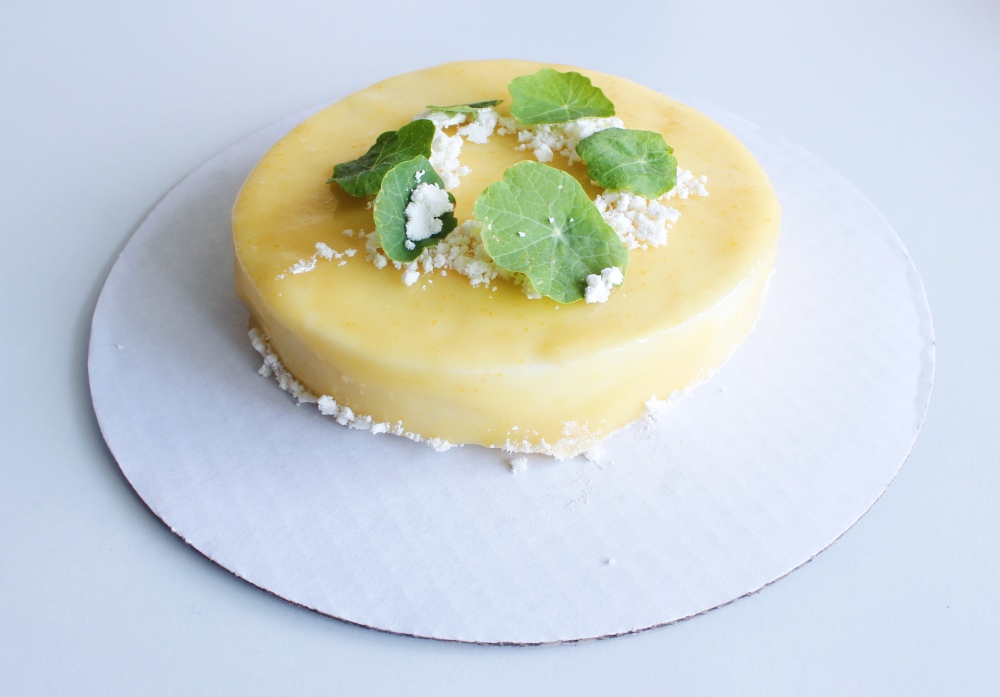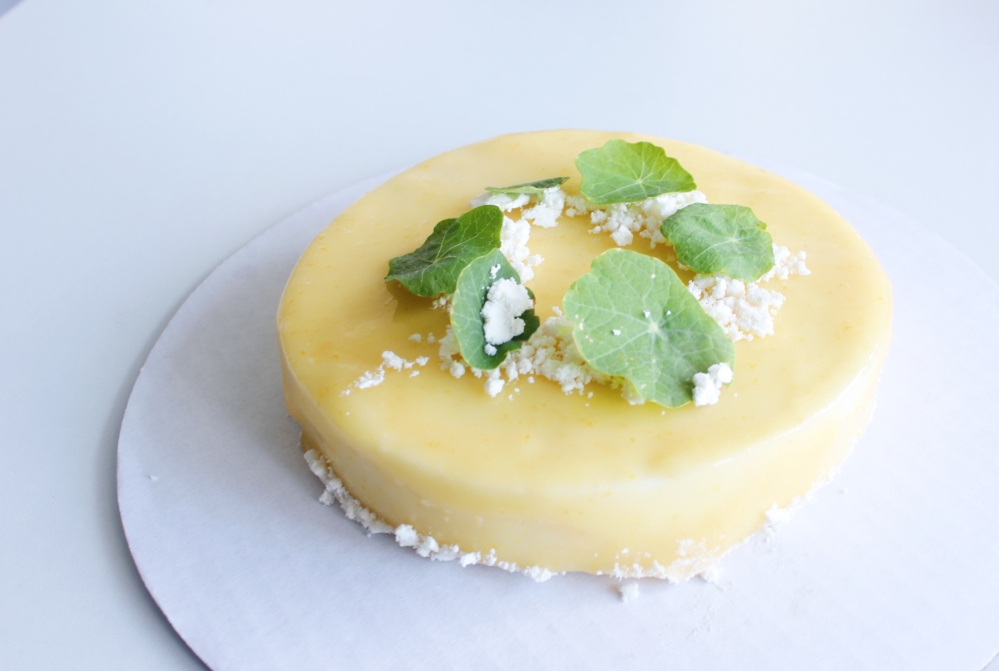With this mousse cake recipe, I was really aiming for something light, using flavors that I knew meshed well together. Lemon and elderflower is a combination I have grown quite fond of, just because you have the tart sharpness of the lemon against the floral, sweetness of the elderflower. The two play off of each other quite well, and I also contrasted those flavors with a little bit of olive oil, to mellow out the sharpness of the lemon, and nasturtiums, which have this pepperiness that play off of the lemon quite well – think lemon-pepper, but in a surprising dessert-friendly way! I kind of wanted this dessert visually to resemble winter melting into spring, and spring giving way to summer, which is was at least the inspiration for some of the components we have in the cake itself. I used a lemon sponge cake as the base, soaking it with elderflower to add that floral, perfume-y quality, and on top of that, we have a lemon-elderflower mousse, a lemon glaze, elderflower “snow”, and the nasturtiums to finish. The cake itself is extremely light, containing no actual fat in it beyond just a single egg yolk. I used a little bit of cornstarch as well, since that lightens up the cake significantly – cornstarch does not contain gluten, and while gluten is what gives a cake structure, too much of it results in a really tough cake. The cornstarch helps in creating a softer, lighter crumb on the cake itself, which is definitely more preferable in a dessert where the cake is strictly the base, and it is accompanying a mousse.

With the components, we have the lemon sponge, an elderflower soak, an elderflower-lemon mousse, a lemon glaze, elderflower snow, and nasturtiums to finish. What I love about the nasturtiums are that they are pretty abundant here in Southern California where I am from, and they grow on 90% of the hiking trails I go on, so foraging them wild was pretty easy. The flowers are this gorgeous orange, red, or yellow color, while the leaves, which are what I snagged for this cake, kind of look like lily pads. In the case of both, they have this light pepperiness that plays off of citrus, chocolate, and seafood quite nicely, so it just made sense to use them as a garnish for this cake in lieu of actual elderflowers. I mention the perfumey-ness of elderflower quite frequently, but to give more context, it tastes like lychee in terms of both sweetness and the floral qualities. I combined the elderflower liquor with olive oil and maltodextrin powder to create a snow-like powder, which I garnished the cake with, just so that it kind of looks like winter is melting away for spring. Except without the muddy colored slush that floods the sidewalks and streets, a visual and an experience of which I do not miss from my days of living in Boston. The lemon has a more wintery connotation to it, while the elderflower feels more like summer, since the similar-tasting lychee is more in season during that time period, while the nasturtium has a more spring-like vibe to it, so the three ingredients really do come together to form that winter giving way to spring to summer-aesthetic and feel that I was going for in this cake!
For the sponge:
2 egg whites
1/4 cup granulated sugar
1g baking powder
2 tsp lemon juice
1 egg yolk
1/2 tsp vanilla extract
a pinch of salt
3 tbsp all-purpose flour
1 tbsp cornstarch
1 tsp finely grated lemon zest
In a bowl whip egg whites with sugar and baking powder to stiff peaks. In another bowl, mix lemon juice and zest, egg yolk, vanilla and salt together. Sift the flour and cornstarch into the egg white bowl, and pour in the egg yolk mixture. Fold everything together into a cohesive batter. Line 1 6-inch ring molds with aluminum foil and cooking spray. Pour the batter into the mold, spreading it into an even layer. Bake at 350 degrees F for 15 minutes. Turn the cake upside down onto a lined sheet tray and remove the aluminum from the bottom. Scrape the sides of the ring mold to allow the cake to release from the mold without tearing apart. Allow the cake to cool upside down, so that they become perfectly cylindrical and flat.
For the elderflower soak:
1 tbsp elderflower liquor
2 tbsp water
a pinch of salt
1/4 tsp vanilla extract
Mix everything together and keep refrigerated for initial assembly.
For the lemon mousse:
juice and zest from 3 lemons
1 tsp gelatin powder + 1 tbsp cold water
1 egg yolk
2 tbsp cornstarch
1/4 cup granulated sugar
1 tbsp elderflower liquor
1 tsp vanilla extract
1/2 cup heavy cream, whipped stiff and kept cold
In a pot, heat up lemon juice and zest and the gelatin powder. In a bowl, whisk together the egg yolk, cornstarch, sugar, and liquor. Pour half of the heated lemon juice into the egg yolks while whisking, then return the egg yolk mixture into the pot with the lemon juice, whisking everything on medium-low heat until it begins to cling to the sides of your whisk. Pass the mixture through a sieve to remove any lumps, and allow it to cool down to lukewarm. Then add in the vanilla, and fold into that the heavy cream to form your mousse.
For initial assembly:
In a lined 6-inch ring mold, pour in the mousse. Brush the cake with your soak, and press that in as well. Freeze for at least 4 hours before attempting to unmold. Keep the cake frozen for glazing.
For the lemon glaze:
juice and zest from 2 lemons
1 tbsp cornstarch
1 tbsp granulated sugar
1 tsp gelatin powder + 2 tbsp cold water
1/4 cup water
1/4 cup white chocolate chips
a pinch of salt
In a pot, whisk together the lemon juice, zest, cornstarch, sugar, and gelatin on medium heat until combined and thickened. Pass through a sieve to remove the zest, and return to a pot. Add in the other ingredients and heat up on low until everything is melted together. Allow the glaze to cool down to about 90 degrees F before pouring over the still-frozen mousse cake to glaze it. Allow the glaze to set around the mousse cake for at least 5 minutes before attempting to transfer to another surface.
For the elderflower dust:
1 tbsp olive oil
1 tsp elderflower liquor
4 tbsp tapioca maltodextrin
a pinch of salt
Combine together to form a powder.
To garnish:
Nasturtiums
Garnish the bottom and top of the cake with the elderflower dust and nasturtiums.
